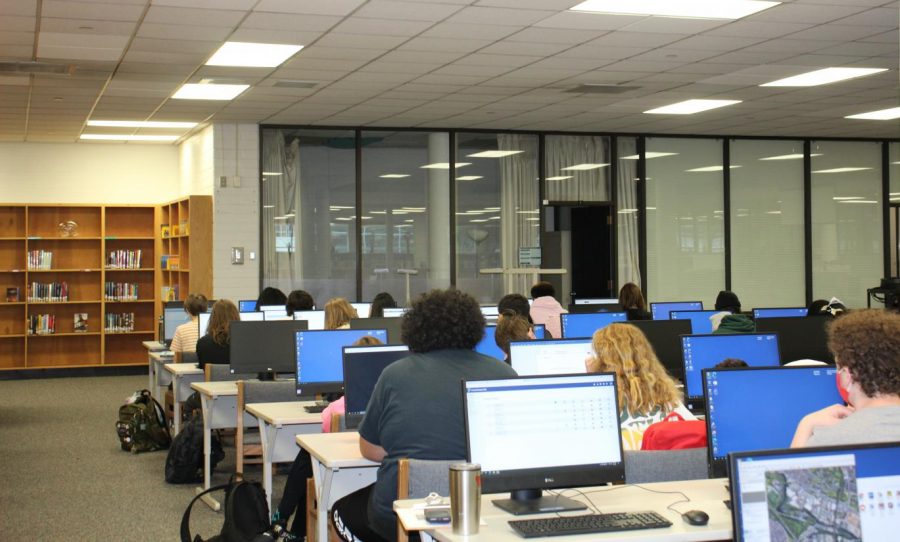Lack of Laptops Worries Highland
Highland students take a test in the library
September 2, 2021
As everyone knows, this past year was the year of masks, social distancing, and virtual learning. Though some of these elements are carried on into the school year of 2021-22 as COVID-19 makes another surge, one major change is that school is 100% back in person. After relying so heavily on computers and laptops to access education last year, some are wondering what place technology will keep in the classroom.
Though many teachers recognized the struggles of students adjusting to online learning last year, there were some positives to the situation. For example, Jennifer Jacobsen appreciated the opportunity to transition to a paperless classroom, something she would like to implement in the future even when learning is in-person.
“If kids have access to computers, I don’t ever want to go back to using paper,” Jacobsen said earlier in the pandemic, when Highland was first adjusting to online learning.
However, the issue for this year may be just that: there are not enough computers in Highland’s system thanks to the major increase in this year’s student enrollment. According to Linda Lesue, Highland’s assistant principal, there are about 250 more students at Highland than the usual capacity.
Lesue believes that this is because many students are coming to Highland instead of Olympus, Skyline, or other schools around the valley.
“I think it’s mostly because they feel like highland is a good school,” she said, which is a credit to the great programs here, but it also has downsides since the building is already next to overflowing with kids. There is not enough space, nor supplies, for the mass influx of students.
During distanced learning, having access to the internet was crucial for students to maintain their education.
“Last year, there were enough computers for the students who needed them, but there wasn’t a 1:1 ratio,” Lesue explained, because fortunately some students were able to use their own personal computers.
In fact, according to her, the Salt Lake City School District has never publicly announced a goal to become a 1:1 ratio. Unless Highland High can somehow dramatically increase its budget in the near future, having a computer for every student is extremely implausible.
Now, however, “teachers are frustrated that all students don’t have access to laptops because [the teachers] worked so hard on their curriculum and their canvas pages, and now that’s not useful,” Lesue said.
Several Highland faculty are finding ways to adjust, because they feel that some elements of online school are very important to students.
For example, Jacobsen explained that in addition to the benefit of decreasing paper waste, having access to canvas allows her to establish a “flipped” classroom, in which students read the day’s materials before coming to class, where they can then discuss what they learned, a strategy purported to maximize teacher time and student engagement.
Jacobsen is making this possible because this year, she has a laptop cart dedicated solely to her classroom. She teaches many credit recovery classes as well as AP Human Geography. An online program is required for these credit recovery classes, so Jacobsen has been assigned her own laptop cart.
As if a shortage of laptops wasn’t enough, Highland’s increase in enrollment has necessitated the conversion of two computer labs to new classrooms. This could prove to be an issue because not only will this reduce the number of computers students can access for canvas, but there are also several state-mandated assignments that students must complete online, such as the Reading Inventory test.
Though many teachers both this year and last year expressed excitement at the opportunity to run more paperless classrooms, there are several factors that make this goal extremely lofty. Every teacher is handling the situation in their own way, but it is largely unclear what role computers will continue to play in education throughout this year and into the future.




























